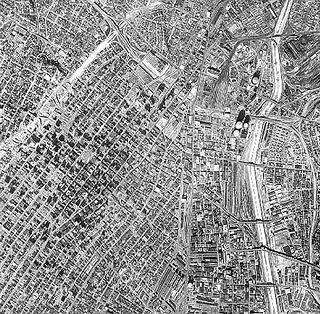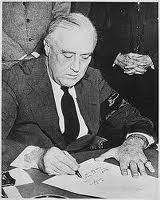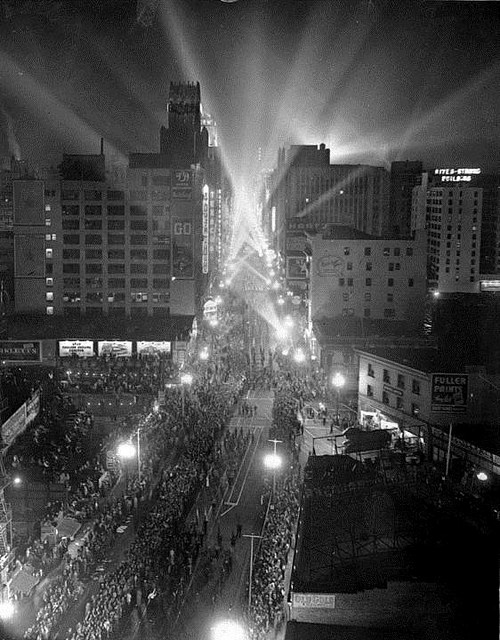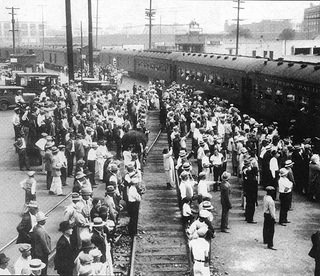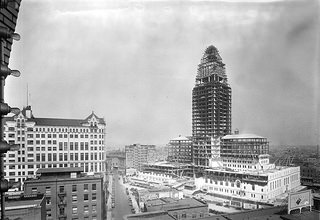Olvera Street gains Historic Landmark status
During the 1920s, the pace of Mexican immigration into the state increased rapidly. California was a primary destination with Los Angeles being a common choice. As a part of a movement that sought to preserve what was then seen as California's "authentic" heritage, resident Christine Sterling began a public campaign to renovate Francisco Avila Adobe, which evolved into a campaign “to preserve and present the customs and trades of early California" at Olvera Street through sustaining the Mexican marketplace which had been thriving since the 1880s. The campaign was ...
LA in the 1950s
Ariel image of downtown Los Angeles in 1952, showing homes of some of the 1,970,358 residents.
Japanese Americans Forced to Move to Internment Camps
A total of 92,193 Japanese Americans were transferred to these temporary detention centers from March to August 1942. Many Japanese Americans who resided in Los Angeles lived in Little Tokyo and were forced to relocate to Manzanar and Tule Lake, losing their homes, businesses, belongings and freedom. The image on the left is of Los Angeles residents getting on the Pacific Electric train at the Santa Anita Park, which became an "assembly center" for Japanese Americans forced to relocate to internment camps. The photograph was taken on April 3, 1942.
All but four of the ...
“Assembly Centers” in Little Tokyo
With the outbreak of the Pacific War, all people of Japanese descent living on the West Coast were removed from their homes and incarcerated, subject to mass removal and incarceration. To prove their loyalty, many American-born men served in the army or military intelligence service. Their heroic contributions helped the Nisei to break through racial barriers and gain rapid social mobility after the war. The image on the left is of the Nishi Hongwanji Buddhist Temple in Los Angeles’ Little Tokyo (currently the Historic Building of the Japanese American National Museum), ...
Executive Order 9066 and the WCCA
Executive Order 9066, signed by Franklin D. Roosevelt on February 19, 1942, authorized the removal of all persons of Japanese ancestry from the West Coast by authorized military commanders to designated military areas, however, it was signed before there were any fully constructed sites to house the displaced Japanese Americans. After the voluntary evacuation program failed to entice many families to leave the exclusion zone, the military took charge of the now-mandatory evacuation. On April 9, 1942, the Wartime Civilian Control Administration (WCCA) was established to ...
Sonoratown becomes “New Chinatown”
By the time novelist J. Torrey Connor sauntered down the streets of Sonoratown in the early twentieth century, market forces were already pushing the barrio to disintegration. The Southern Pacific had built its railyard and depot on the outskirts of the neighborhood, transforming Sonoratown into valuable industrial real estate. As property values rose, the district's adobes and shacks gave way to warehouses and factories. Tourists searching for the region's mythical past could still find it on Olvera Street—invented in 1930 by socialite Christine Sterling and Los Angeles ...
The Hoover Dam powers Los Angeles
Tens of thousands of people jammed the parade route on Broadway on the night of October 9, 1936, as the street became ablaze with light when the first power streaked 266 miles from the Hoover Dam Power Plant to Los Angeles.
Hoover Dam, once known as Boulder Dam, is a concrete arch-gravity dam in the Black Canyon of the Colorado River, on the border between the U.S. states of Arizona and Nevada. It was constructed between 1931 and 1936 during the Great Depression and was dedicated on September 30, 1935, by President Franklin D. Roosevelt. Its construction was the result ...
The Mexican-American Deportation and Repatriation
During the 1930s, tens of thousands, and possibly more than 400,000, Mexicans and Mexican-Americans were pressured — through raids and job denials — to leave the United States during the Depression after the stock market crashed in 1929. This deportation was enforced without due process.
Officials staged well-publicized raids in public places. For example, on Feb. 26, 1931, immigration officials suddenly closed off La Placita, a square near Olvera Street and about 1.4 miles north of Azusa Street, and questioned the roughly 400 people there about their legal status...
Avila Adobe
Don Francisco Avila, a wealthy cattle rancher and one-time Mayor of the pueblo of Los Angeles, built the Avila Adobe in 1818. The Avila Adobe, presently the oldest existing residence within the city limits, was one of the first town houses to share street frontage in the new Pueblo de Los Angeles.
In 1930, through the efforts of activist Christine Sterling, the Plaza-Olvera area was revived with the opening of Paseo de Los Angeles (which later became popularly known by its official street name Olvera Street). Receiving recognition, Avila Adobe is preserved as “the ...
City Hall is Constructed and Dedicated
Los Angeles City Hall is the center of the government of the city of Los Angeles, California, and houses the mayor's office and the meeting chambers and offices of the Los Angeles City Council. It is located in the Civic Center district of downtown Los Angeles in the city block bounded by Main, Temple, First, and Spring streets.
The building was designed by John Parkinson, John C. Austin, and Albert C. Martin, Sr., and was completed in 1928. Dedication ceremonies were held on April 26, 1928. It has 32 floors and, at 454 feet high, is the tallest base-isolated structure ...



